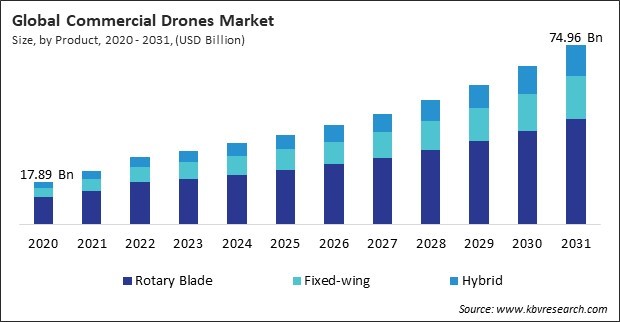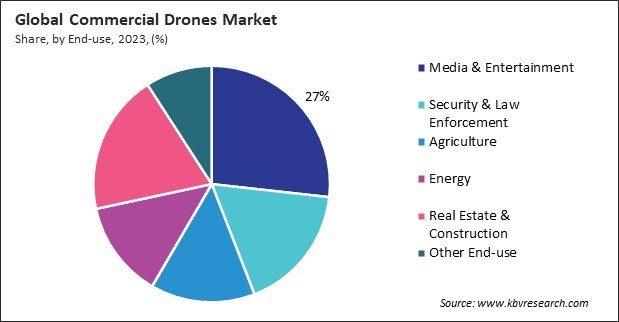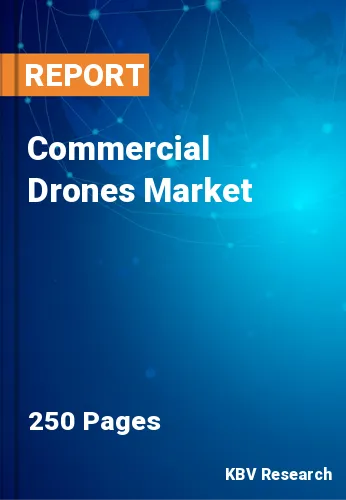“Global Commercial Drones Market to reach a market value of 74.96 Billion by 2031 growing at a CAGR of 12.1%”
The Global Commercial Drones Market size is expected to reach $74.96 billion by 2031, rising at a market growth of 12.1% CAGR during the forecast period.
With the integration of sensors, cameras, and mapping technologies, drones have enabled farmers to monitor crop health, assess soil conditions, and optimize irrigation, increasing efficiency and sustainability. These drones allow precision farming, where resources like water, fertilizers, and pesticides are applied only where needed, minimizing waste and environmental impact. Hence, in 2023, the precision agriculture segment procured 14% revenue share in the market. This not only boosts crop yields but also helps in reducing operational costs. As agriculture continues to adopt more technologically advanced solutions to meet the growing food demand, drones are becoming an indispensable part of the industry, contributing significantly to their rising share in the market.

Drones play a growing role in urban safety by assisting in traffic monitoring and crowd management. By providing aerial perspectives, drones can identify potential risks and streamline operations in real-time. These capabilities are driving their adoption by government agencies and private organizations dedicated to public safety. Thus, the rising adoption of commercial drones for public safety will drive market growth. Additionally, continuous advancements in artificial intelligence (AI) and machine learning (ML) improve drones’ data processing capabilities. These technologies enable real-time analysis and actionable insights, making drones a critical tool for industries aiming to optimize operations and ensure sustainability. In conclusion, the growth of advanced technology and expanded GIS and LIDAR services applications is driving the market's growth.
However, Drones pose security risks when used maliciously for spying, smuggling, or even as weapons. Governments and businesses face the challenge of preventing unauthorized drone activities, which can compromise national security and corporate confidentiality. Implementing counter-drone technologies and legal frameworks is crucial to mitigating these risks. The lack of standardized global regulations further complicates the issue. While some countries have established comprehensive guidelines for drone usage, others lag, creating inconsistencies. Therefore, security and privacy issues related to drones are hampering the market's growth.
Based on product, the market is divided into rotary blade, fixed-wing, and hybrid. In 2023, the rotary blade segment garnered 62% revenue share in the market. This is because the ability of rotary blade drones to hover and perform agile manoeuvres while retaining a visual on a specific target for extended periods is expected to raise demand for inspection operations. These drones are often a good substitute for various commercial uses, including surveillance, filming, photography, and monitoring.
On the basis of end-use, the market is segmented into media & entertainment, security & law enforcement, agriculture, energy, real estate & construction, and others. The agriculture segment held 14% revenue share in the market in 2023. Due to their ability to provide real-time data on crop health, conditions of the soil, and irrigation requirements, drones have become an essential part of modern farming. These aerial devices help in precision agriculture, allowing farmers to optimize resources such as water, fertilizers, and pesticides, enhancing crop yields and reducing environmental impact. As the agriculture industry continues to seek more efficient and sustainable practices to meet global food demands, drones play a pivotal role, leading to their increasing presence in the market.

By application, the market is divided into filming & photography, mapping & surveying, surveillance & monitoring, inspection & maintenance, precision agriculture, and others. In 2023, the filming & photography segment registered 27% revenue share in the market. Drones are gradually becoming essential to professional photography as photographers eagerly embrace them to gain a competitive advantage. Small drone cameras with the ability to take high-quality photographs for professional photographers are being developed by companies. Additionally, the rise of social media platforms, where visual content plays a pivotal role, further propelled the demand for drones in both professional and amateur filming, contributing to the segment’s dominance in the market.
Free Valuable Insights: Global Commercial Drones Market size to reach USD 74.96 Billion by 2031
Region-wise, the market is analyzed across North America, Europe, Asia Pacific, and LAMEA. The North America region witnessed 38% revenue share in the market in 2023. This is due to advancements in drone technology, beneficial government initiatives, and rising demand from businesses in various sectors. The United States, in particular, has been a key player in the commercial drones sector, with a well-established regulatory framework, a high level of technological innovation, and significant investments in drone technology. Some regional governments are releasing new regulations to establish more consistent and reasonable criteria for the safe and lawful use of UAVs in commercial settings.
| Report Attribute | Details |
|---|---|
| Market size value in 2023 | USD 30.78 Billion |
| Market size forecast in 2031 | USD 74.96 Billion |
| Base Year | 2023 |
| Historical Period | 2020 to 2022 |
| Forecast Period | 2024 to 2031 |
| Revenue Growth Rate | CAGR of 12.1% from 2024 to 2031 |
| Number of Pages | 260 |
| Tables | 410 |
| Report coverage | Market Trends, Revenue Estimation and Forecast, Segmentation Analysis, Regional and Country Breakdown, Porter’s 5 Forces Analysis, Company Profiling, Companies Strategic Developments, SWOT Analysis, Winning Imperatives |
| Segments covered | Product, End-use, Application, Region |
| Country scope |
|
| Companies Included | AeroVironment, Inc., Intel Corporation, SZ DJI Technology Co., Ltd., EHang Holdings Limited, Aeronavics Ltd., Parrot Drones SAS, Draganfly Inc., Autel Robotics Co., Ltd., PrecisionHawk, Inc. (Field Group AS), Terra Drone Corporation (Terra Motors Corporation) |
By Product
By End-use
By Application
By Geography
This Market size is expected to reach $74.96 billion by 2031.
Growth of Advanced Technology and Expanded Applications for GIS and LIDAR Services are driving the Market in coming years, however, High Initial Costs of Drone Acquisition and Deployment restraints the growth of the Market.
AeroVironment, Inc., Intel Corporation, SZ DJI Technology Co., Ltd., EHang Holdings Limited, Aeronavics Ltd., Parrot Drones SAS, Draganfly Inc., Autel Robotics Co., Ltd., PrecisionHawk, Inc. (Field Group AS), Terra Drone Corporation (Terra Motors Corporation)
The expected CAGR of this Market is 12.1% from 2023 to 2031.
The Media & Entertainment segment is leading the Market by End-use in 2023; thereby, achieving a market value of $17.51 billion by 2031.
The North America region dominated the Market by Region in 2023; thereby, achieving a market value of $26.28 billion by 2031.
Our team of dedicated experts can provide you with attractive expansion opportunities for your business.

 Drivers
Drivers
 Restraints
Restraints
 Opportunities
Opportunities
 Challenges
Challenges
